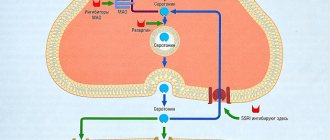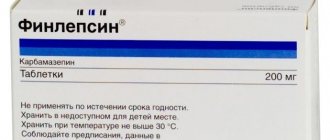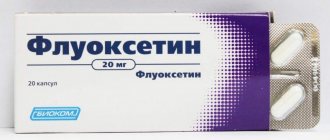Remedy for the blues
Prozac was the first antidepressant in the history of our planet.
It was he who became the progenitor of a huge number of similar drugs, which grew into an incredibly influential pharmacological industry, the activities of which are based on promising people mental stability and even happiness. However, other reviews about Prozac are less positive - a number of experts are convinced that it was this drug that gave birth to depression as a disease, because, as you know, a little over three decades ago no one could even imagine the existence of such a diagnosis. And Prozac was not created for this purpose at all, but as part of the development of a drug to correct high blood pressure. The side effect was discovered in additional clinical studies. As it became clear from the group of subjects, when taking Prozac capsules their mood improved. Later this was called stabilization of the mental state, and the medication itself was dubbed a remedy for mild depressive disorders.
Release form and composition
Dosage form - capsules: size No. 3, gelatin, hard, green/cream, opaque, with the identification code “3105” and the “LILLY” logo; contents – white powder (in blisters of 14 pcs., in a cardboard pack 2 blisters).
Active substance: fluoxetine (in the form of hydrochloride) – 20 mg in 1 capsule.
Auxiliary components: dimethicone and starch.
Composition of the capsule shell: gelatin, titanium dioxide, yellow iron oxide dye, patent blue dye (patent blue dye V), food ink (used for applying identification stamps).
Prozac is available in the form of capsules: hard gelatin, opaque, green/cream, size No. 3; the contents of the capsules are white powder (14 pieces in blisters, 1 or 2 blisters in a cardboard pack).
1 capsule contains:
- Active ingredient: fluoxetine (in the form of hydrochloride) – 20 mg;
- Auxiliary components: dimethicone, starch;
- Capsule shell: titanium dioxide, food ink, gelatin, yellow iron oxide dye, patented blue dye.
Prozac prices in pharmacies
In accordance with Federal Law No. 429-FZ of December 22, 2014 “On Amendments to the Federal Law “On the Circulation of Medicines”, the remote sale of over-the-counter drugs is permitted from April 1, 2020. The sale and delivery of narcotic, psychotropic and medicines with an ethyl alcohol content of more than 25% is prohibited. Please check with pharmacies for current terms of payment and delivery of medications.
| Drug name | Price for 1 unit. | Price per pack, rub. | Pharmacies |
| Prozac® capsules 20 mg, 14 pcs. blister 14, cardboard pack 1 EAN code: 4602103002521 No. P N014206/01, 2008-03-17 Eli Lilly Vostok SA (Switzerland) | |||
| 31.36 profitable | 439.00 | ||
| 32.71 | 458.00 | ||
| 33.64 | 471.00 | ||
| 33.64 | 471.00 |
Where to buy Prozac?
We promote wisely
The drug Prozac was created by a company from Switzerland – Eli Lilly Vostok. As soon as it was discovered that the new product had a strong impact on the mental state of patients, it was decided to promote a new method of treating blues, which has since been called a serious illness - depression. The effect (“Prozac” showed it in almost 100% of cases) made it possible to announce the invention of the happiness pill.
The advertising campaign found widespread support among film and television stars. It has become fashionable to talk about severe depression and the remedies that should be used for treatment. Of course, alcohol and Prozac immediately became fashionable. This is also evidenced by the popular book “Prozac Nation,” which was soon filmed. It must be said that the authors of works of fiction did not present the drug in the best possible way.
Indications for use
For adults:
The drug is prescribed for the following pathologies:
- Depression of various etiologies
- Bulimia nervosa
- Obsessive-compulsive disorder
- Premenstrual dysphoric disorder
- Major depressive episodes.
- Bulimia nervosa: as an adjunct to psychotherapy to reduce uncontrolled eating.
For children:
The drug is not used to treat patients under 18 years of age.
Overdose and side effects
Prozac should be taken orally with or without food.
Recommended daily doses for adult patients:
- Obsessive-compulsive disorders – 20-60 mg;
- Depression – 20 mg;
- Premenstrual dysphoric disorder – 20 mg;
- Bulimia nervosa – 60 mg.
Depending on the clinical situation, the dose can be reduced or increased. The maximum daily dose is 80 mg; higher doses have not been studied.
Patients who are taking other drugs at the same time, have concomitant diseases or impaired liver function, it is necessary to reduce the dose of fluoxetine or increase the interval between doses.
The drug is taken orally, regardless of food intake.
Recommended doses (per day):
- Bulimia nervosa – 60 mg;
- Depression – 20 mg (initial dose);
- PMDD – 20 mg;
- Obsessive-compulsive disorder – 20-60 mg.
It is possible to increase or decrease the recommended doses, but the use of Prozac at a daily dose of more than 80 mg has not been studied.
In patients with concomitant diseases, impaired liver function, or taking other medications, it is necessary to reduce the dose of the drug and reduce the frequency of its administration.
There are no data on dose adjustment depending on the patient's age.
There were 633 registered cases of overdose while taking Prozac at the end of 2016. Most of these patients were able to successfully recover. According to the study, the minimum dose at which an overdose occurred is 80 mg.
There was also a case of overdose with an amount of 52 mg of the active ingredient per day, but no direct connection between the dosage and death was identified.
Despite the fairly large list of side effects, the main manifestations of an overdose are the following symptoms: nausea and vomiting, drowsiness, convulsions, increased heart rate.
The side effects that occur when taking Prozac are generally characteristic of drugs from the group of selective serotonin reuptake inhibitors:
- Adverse reactions from the cardiovascular system can manifest as hot flashes, an increase in the lumen of blood vessels and a decrease in blood pressure as a result.
- From the gastrointestinal tract, dry mouth, vomiting, diarrhea, changes in taste sensations and the appearance of pain in the esophagus, loss of appetite and, as a result, loss of body weight may appear.
- The nervous system most often manifests itself as fatigue and weakness; headache, dizziness and drowsiness may appear. Feelings of cold or heat may also appear, and anxiety and restlessness may increase. Less common symptoms include cramps, insomnia, decreased libido, and inability to achieve orgasm. Pupil dilation and decreased visual acuity may occur. Side effects include the risk of developing mania and hypomania, as well as disturbances in thinking, but these cases are rare.
- From the genitourinary system, men may experience ejaculation disorders and impotence. In women, bleeding from the vagina. Both sexes may experience urinary problems: too frequent trips to the toilet and pain.
- Allergic reactions are possible, which may manifest as skin rashes and itching. The patient may also experience increased sweating, muscle and joint pain, increased body temperature and heavy breathing.
At the initial stage of therapy, most patients strictly follow the doctor’s recommendations and do not exceed the dose.
However, with long-term use of the drug, dependence on fluoxetine develops, the patient has difficulty adhering to the therapy prescribed by the doctor, and the body begins to require the drug in a larger dosage.
Many patients note that the new sensations that arise when taking the drug cause them a state of satisfaction,
euphoria
.
Some patients compare the effects of Prozac to narcotic substances.
Exceeding the dose of an antidepressant does not go away without leaving a trace.
Overdose is accompanied by characteristic symptoms:
- nausea;
- vomiting;
- disruption of the heart muscle (up to cardiac arrest);
- respiratory system disorder;
- mental attacks;
- a sharp change in the functioning of the central nervous system (ranges from an inadequate, overly excited state to coma).
There have been cases of death due to an overdose of Prozac.
At the moment, no specific antidote has been identified. The patient is prescribed symptomatic therapy and monitoring of heart function. In severe condition, the patient is placed in the intensive care unit.
Pharmacological action of Prozac
The active ingredient in Prozac is fluoxetine, a product of propylamine. Fluoxetine is a substance that blocks the reuptake of serotonin, known as the “happy hormone,” in nerve cells of the central nervous system. The peculiarity of this chemical compound is that by interfering with the metabolism of serotonin, it does not affect other similar substances, namely acetylcholine, dopamine, histamine, norepinephrine and others, thus exerting a selective effect.
As a result, Prozac helps reduce anxiety levels, feelings of fear, reduces psycho-emotional stress, reduces symptoms of depression, eliminates depression, and reduces stress. Does not have any undesirable effects on the cardiovascular system.
Reviews
After difficult events in my life, depression began. Unable to cope on my own, I turned to a specialist who prescribed me long-term therapy with the drug Prozac.
I took the pills daily, but did not notice any changes. I wanted to stop treatment because I did not observe any effect. However, the doctor assured that the antidepressant has a cumulative effect.
I felt improvements after 2 weeks. My mood improved and my interest in life began to appear.
Kristina, 34 years old, Moscow: A very heavy drug. I took Prozac to treat bulimia neurotic, and with the help of this medication I was able to cope with the problem. However, she developed a strong dependence on it, and after stopping the drug she experienced a state of “withdrawal.”
I categorically do not recommend abruptly stopping taking the pills; the dose must be slowly reduced, then the “withdrawal syndrome” will not be so pronounced.
Patients with liver and kidney problems should take the drug with extreme caution. It is not recommended to take the medicine for epilepsy. And taking the medication in combination with electroconvulsive therapy can generally lead to prolonged epileptic seizures.
Prozac can also change blood glucose levels, so for patients with diabetes it is necessary to adjust the intake of glucose-lowering medications.
Prozac is contraindicated during pregnancy and breastfeeding. The safety of the product when taken by children has not been established. Elderly people need to take the medicine with extreme caution; a special dosage is prescribed for them, which takes into account the individual characteristics of the body.
The simultaneous use of SSRIs and alcohol is unacceptable. Alcohol must be strictly avoided during treatment.
Also, during the treatment period, it is better to refrain from life-threatening activities, where you must always be collected, and the reaction must be lightning fast.
Prozac, according to many patients, is not the most effective remedy. As the patients who completed the course noted during the research, at first the condition improved, but over time the reverse process occurred. With long-term use, all those undergoing treatment experienced a loss of interest in life, including important and joyful moments.
According to non-specialists, a person “becomes a vegetable” and cannot experience emotions. Is Prozac sold in pharmacies with a prescription or not? Due to the abundance of the mentioned negative responses and wide public outcry, the antidepressant, which was sold freely at first, is now sold strictly with a prescription from the attending physician.
People treated with Prozac noted a strong decrease in sexual desire until it completely disappeared. Many also complained of fatigue and lethargy, a reluctance to do anything and an inability to motivate themselves to be active. According to them, it becomes difficult to concentrate, they suffer from headaches, and problems with blood pressure may begin.
Some reviews contain references to increased aggressiveness and irritability. But others, under the influence of Prozac, become completely indifferent, indifferent, including in very important life situations, since they lose the opportunity to assess the significance of what is happening. Some studies have shown that long-term Prozac users are more likely to attempt suicide. When prescribing treatment with this drug after such an attempt, there is a high probability of relapse.
Application[ | ]
Indications[ | ]
Depression (regardless of the degree of depressive disorder - mild, moderate, severe), including in the structure of other mental disorders - schizophrenia, bipolar disorder [ source not specified 65 days
], schizoaffective psychoses. Bulimia nervosa, alcoholism, obsessive-compulsive disorder.
Fluoxetine is especially effective with olanzapine and is produced in combination with it under the name Symbiax. for the treatment of bipolar depressive episodes and resistant depression[9][10].
Contraindications[ | ]
Hypersensitivity to the drug, liver disease[11], chronic renal failure (creatinine clearance less than 10 ml/min.), bladder atony, glaucoma, prostate adenoma, decompensated epilepsy[12], history of convulsive reactions, diabetes mellitus[13] , suicidal ideation[1], manic states (both current[12] and in history[14]), poisoning with alcohol, psychotropic drugs and other drugs[15], pregnancy, breastfeeding[12][1] , age less than 15 years[16].
With caution[ | ]
Compensated renal and/or liver failure, diseases of the cardiovascular system[1], Parkinson's disease, cachexia.
Drug interactions
- Digestive system: nausea, dysphagia, taste disturbance, diarrhea, vomiting, dyspepsia; in isolated cases - idiosyncratic hepatitis;
- Genitourinary system: prolonged erection/priapism, urinary disorders (including frequent urination), sexual disorders (lack or delayed ejaculation, impotence, decreased libido, lack of orgasm);
- Central and peripheral nervous system: tremor, myoclonus, ataxia, convulsions, bucco-glossal syndrome, anorexia (sometimes to significant weight loss), fatigue (asthenia, drowsiness), manic reaction, anxiety (accompanied by restlessness, agitation, palpitations and nervousness) , dizziness, sleep disturbance (insomnia, unusual dreams), impaired thinking and concentration, disorders of the autonomic nervous system (chills, increased sweating, dry mouth, vasodilation), serotonin syndrome, visual impairment (blurred vision, mydriasis);
- Endocrine system: impaired secretion of antidiuretic hormone;
- Dermatological reactions: alopecia, photosensitivity;
- Allergic reactions: urticaria, vasculitis, skin rash, itching, reactions similar to manifestations of serum sickness, anaphylactic reactions;
- Other reactions: ecchymosis, yawning.
Prozac is not recommended to be taken concomitantly with monoamine oxidase inhibitors (MAOIs) and for at least 2 weeks after their discontinuation. Treatment with MAO inhibitors begins no earlier than 5 weeks after discontinuation of fluoxetine.
Treatment with drugs that are metabolized through the CYP2D6 isoenzyme system and have a narrow therapeutic index is started with the lowest doses if the patient is simultaneously receiving Prozac or has taken it within the previous 5 weeks. When prescribing fluoxetine to a patient already taking similar drugs, the dose of the first drug should be reduced.
Prozac may alter the blood concentrations of the following substances when co-administered with them: carbamazepine, clozapine, alprazolam, imipramine, phenytoin, haloperidol, lithium, desipramine and diazepam.
When Prozac is prescribed with drugs that bind tightly to plasma proteins, changes in plasma concentrations of both drugs are possible.
When used together with warfarin, an increase in bleeding time was noted.
The half-life of fluoxetine and norfluoxetine (its active metabolite) is long, which should be taken into account when prescribing other drugs after Prozac is discontinued.
During electroconvulsive therapy in patients taking fluoxetine, there have been cases of increased duration of seizures (rarely).
- From the central and peripheral nervous system: bucco-glossal syndrome, anorexia, myoclonus, ataxia, tremor, fatigue (asthenia, drowsiness), impaired thinking and concentration, dizziness, visual impairment (blurred vision, mydriasis), sleep disorders (insomnia , unusual dreams), manic reaction, convulsions, anxiety (accompanied by restlessness, agitation, palpitations, nervousness), disorders of the autonomic nervous system (increased sweating, chills, dry mouth, vasodilation), serotonin syndrome;
- From the digestive system: taste perversion, dysphagia, nausea, vomiting, diarrhea, dyspepsia; in isolated cases - idiosyncratic hepatitis;
- From the endocrine system: impaired secretion of antidiuretic hormone;
- From the genitourinary system: urinary disorders (including frequent urination), sexual disorders (absence or delayed ejaculation, decreased libido, lack of orgasm, impotence), priapism/prolonged erection;
- Allergic and dermatological reactions: skin rash, itching, urticaria, vasculitis, anaphylactic reactions, alopecia, photosensitivity, reactions similar to manifestations of serum sickness;
- Other: ecchymosis, yawning.
Prozac should not be used concomitantly with monoamine oxidase inhibitors (MAOIs) and for 14 days after their discontinuation. If MAO inhibitors are prescribed after Prozac, the interval between doses should be at least 5 weeks. If fluoxetine was used for a long time or in high doses, then this break should be increased. This is due to the fact that there are known serious cases of serotonin syndrome, including death.
When prescribing drugs that are metabolized by the CYP2D6 isoenzyme and have a narrow therapeutic index to a patient who is receiving fluoxetine or has taken it within the previous 5 weeks, they should be prescribed at minimal doses. If Prozac is prescribed to a patient taking a similar drug, the dose of fluoxetine should be reconsidered. This is due to the fact that fluoxetine has the ability to inhibit the CYP2D6 isoenzyme.
Prozac affects the blood concentrations of diazepam, clozapine, alprazolam, haloperidol, lithium, carbamazepine, imipramine, desipramine, phenytoin. In some cases, toxic effects were observed. If it is necessary to use fluoxetine in combination with any of these drugs, it is necessary to carefully select the dose and monitor the patient's condition.
When fluoxetine is used simultaneously with another drug that binds tightly to plasma proteins, a mutual change in plasma concentrations is possible.
When Prozac is used in combination with warfarin, an increase in bleeding time is observed, so blood clotting parameters should be carefully monitored during treatment and after discontinuation of fluoxetine.
There are isolated cases of increased duration of seizures during electroconvulsive therapy in patients receiving fluoxetine.
When prescribing any drug after discontinuation of Prozac, it is necessary to take into account the long half-life of fluoxetine and norfluoxetine (its active metabolite) and the associated risk of drug interactions.
Taking Prozac in combination with medications that affect the central nervous system, as well as with ethanol, can cause an enhanced depressant effect on the nervous system.
When taken with drugs from the MAO inhibitor group, serotonin syndrome may occur, which is characterized by severe mania, confusion, motor and cognitive impairment, trembling of the limbs, vomiting, chills and convulsions.
Taking Prozac with antidiabetic drugs at the same time may increase their effect on the body.
When combined with the cough suppressant Dextromethorphan, it may cause hallucinations. With Propofol - the appearance of spontaneous movements, with Phenylpropanolamine - dizziness, weight loss and increased activity.
Prozac (fluoxetine): side effects
Side effects that may occur when taking fluoxetine include nausea, drowsiness, dizziness, anxiety, trouble sleeping, loss of appetite, fatigue, sweating, and yawning. If you are concerned about any of these symptoms, tell your doctor. It is also worth remembering that your doctor has prescribed this medication because you believe it will provide you with benefits that are far greater than the risk of side effects. Many people taking Prozac do not experience any side effects at all when taking fluoxetine.
Tell your doctor if you experience any of these unlikely but serious side effects: unusual or serious changes in your mental status (unusually intense or suicidal thoughts, bleeding and general muscle weakness, seizures, unexplained weight loss, decreased interest in sex, disruptions in sexual life).
Seek emergency medical help if you have vomiting (vomit that is tarry and black), fast irregular heartbeat, fainting or seizures, or changes in the color or amount of urine. If you have diabetes, fluoxetine (Prozac) may affect your blood sugar. You need to monitor it constantly and share observations with your doctor. Your doctor may recommend special diets and exercises to reduce the side effects of Prozac.
Prozac can also increase the amount of serotonin in the body and very rarely cause a serious condition called serotonin syndrome. The risk increases if you take other drugs that can increase serotonin along with Prozac. Accordingly, your doctor should know about all the medications you are taking.
Prozac does not usually cause serious allergic reactions, but if your body reacts to the drug with rash, itching, or swelling (especially of the face, tongue, or throat), you should seek immediate medical attention. Fluoxetine (Prozac): Before taking fluoxetine, tell your doctor if you are allergic to this drug or if you are allergic to other medications or any of their ingredients.
Your doctor should also know your complete medical history. At the same time, not only personal, but, if possible, also family. In particular, did any of your close relatives suffer or suffer from bipolar (manic-depressive) disorder, have there been any suicide attempts in your family, do you have liver problems, diabetes, low sodium levels in the blood, whether you are dehydrated, have seizures, or have a medical condition such as a stomach ulcer or glaucoma.
Prozac may cause dizziness and drowsiness. While taking it, it is not recommended to drive a car, operate machinery, or engage in activities that require a certain level of concentration until you are sure that you are fully capable of performing them. Also avoid drinking alcohol while taking fluoxetine.
Fluoxetine may also cause irregular heart rhythm conditions (irregular heartbeats and other symptoms), as well as severe dizziness and fainting. In this case, you need to seek emergency medical help.
Prozac in liquid form contains alcohol. It should be taken with caution by patients suffering from diabetes, alcohol dependence or liver disease. Some drugs, such as metronidazole and disulfiram, can cause a serious reaction when combined with alcohol. Older people, due to the nature of their bodies, may be much more sensitive to the side effects caused by taking Prozac.
Prozac should only be taken during pregnancy when absolutely necessary. This medicine may harm an unborn baby. In addition, babies born to mothers who took Prozac in the last three months of pregnancy may develop withdrawal symptoms, such as difficulty breathing, seizures, muscle stiffness, or constant crying. If you notice any of these symptoms in your newborn, tell your doctor right away.
If you are planning to use Prozac (fluoxetine) to treat depression but think or suspect that you may be pregnant, be sure to discuss with your doctor whether it is appropriate for you to use this drug during this time.
Subscribe to our YouTube channel!
The drug can also pass into breast milk, and then into the owner’s body, which also has negative consequences. If you are breastfeeding, you may also want to talk to your doctor about taking Prozac.
How it works?
The main component of Prozac prevents the brain's receptors from capturing serotonin. Due to this, the compound stays in the brain longer, provoking euphoria. To this day, the etiology of depression causes much debate among specialists, but many doctors believe that in most cases the depressed state is explained precisely by a lack of serotonin.
Despite official clinical trials showing that the described medication is effective in most cases, many believe that the action of Prozac provokes mental disorders, especially with long-term use. It is believed that addiction develops to this drug, and if you stop taking it, you may experience an unpleasant withdrawal syndrome. At the same time, the ineffectiveness of Prozac, which many patients complain about during long-term treatment, forces them to switch to other drugs.
Pharmacodynamics and pharmacokinetics
Prozac is an antidepressant. Wikipedia says that its active substance, fluoxetine, is capable of blocking the reuptake of the neurotransmitter serotonin by functional brain cells - neurons.
Fluoxetine hardly binds to other types of receptors. For example, it has no affinity for dopaminergic, adrenergic, cholinergic histamine receptors. Providing a pronounced antidepressant effect, the drug is able to reduce anxiety, tension, removes feelings of fear, improving mood, and also reduces dysphoria.
After oral administration, fluoxetine is absorbed in the digestive tract, binding to plasma proteins (more than 90%), distributed evenly throughout the body. Peak concentration in blood plasma occurs 6-8 hours after the first dose, while equilibrium concentration is established only after 2-3 weeks of the course.
Metabolism occurs almost entirely to norfluoxetine and other unidentified substances. It is excreted by the kidneys, the half-life of the drug is 4-6 days, and the active metabolite of fluoxetine is 4-16 days.
Fluoxetine has a relatively high bioavailability (72%), and peak plasma concentrations after dosing are achieved within 6 to 8 hours. It binds well to plasma proteins, mainly to albumin. Fluoxetine is metabolized in the liver by isoenzymes of the cytochrome P450 system, including CYP2D6.
The role of CYP2D6 in the metabolism of fluoxetine may be clinically important as there is great genetic variability in the functioning of this enzyme among individuals. Only one metabolite of fluoxetine, norfluoxetine (N-demethylated fluoxetine), is biologically active. Fluoxetine and its active metabolite norfluoxetine are distinguished from other antidepressants by their extremely slow elimination from the body.
Over time, fluoxetine and norfluoxetine inhibit their own metabolism, causing the half-life of fluoxetine to change from 1 day to 3 days after a single dose, and 4 to 6 days after long-term use. In addition, after long-term use, the half-life of norfluoxetine increases (16 days).
Thus, during the first few weeks of treatment, the concentration of the drug and its active metabolite in the blood continues to increase. Constant concentration in the blood is achieved after four weeks of use. In addition, at least during the first five weeks of treatment, the concentration of fluoxetine and its metabolites in the brain continues to increase.
This means that after using the current dose, the drug will take at least a month to take effect. For example, in one 6-week study, the median time to achieve a consistent response was 29 days. In addition, it may take several weeks for the drug to be completely eliminated from the body.
During the first week after cessation of treatment, the concentration of fluoxetine in the brain decreases by only 50%, the level of norfluoxetine in the blood 4 weeks after cessation of treatment is about 80% of the level at the end of the first week of treatment, and 7 weeks after cessation of treatment, norfluoxetine is still can be detected in the blood.
The PET study compared the effects of a single dose of Fluoxetine in exclusively heterosexual and exclusively homosexual men who stated that their past and present sexual behavior, desires, and fantasies were directed exclusively toward women or toward men, respectively.
The study found that in some areas of the brain, the metabolic response occurred differently in the two groups. “Both groups, however, show similarities in broadly lateralized metabolic responses to fluoxetine (compared to placebo), with most brain regions responding similarly in the groups.”
These groups "did not differ in behavioral characteristics or blood levels of fluoxetine." Fluoxetine is a selective serotonin reuptake inhibitor and to some extent inhibits the reuptake of norepinephrine and dopamine. However, Eli Lilly researchers found that when a single large dose of Fluoxetine was administered to rats, there was also a significant increase in the concentrations of norepinephrine and dopamine in the brain.
This effect may be mediated by 5HT2a receptors and, in particular, 5HT2 receptors, which are inhibited by higher concentrations of fluoxetine. Eli Lilly scientists also suggested that effects on dopamine and norepinephrine receptors may enhance the antidepressant effects of fluoxetine.
According to other researchers, the strength of this effect, however, remains unknown. When fluoxetine was taken at lower, more clinically relevant doses, no increases in dopamine and norepinephrine levels were observed. In addition, electrophysiological studies have shown that changes in the activity of norepinephrine neurons in rats were observed only when taking high doses of Fluoxetine.
Some authors, however, argue that these data may still have clinical significance for the treatment of severe illness when fluoxetine is taken in supra-therapeutic doses (60-80 mg). Compared to other SSRIs, "Fluoxetine is the least selective," showing a 10-fold difference in binding capacity between the first and second neural targets (eg, the serotonin and norepinephrine pumps, respectively).
All values greater than a 10-fold difference result in negligible activation of secondary neural targets. In addition to its known effects on serotonin, fluoxetine also increases the density of endogenous opioid receptors in the brain in rats. It's unclear whether the same thing happens in humans, but if so, it could explain some of the antidepressant or side effects of Fluoxetine.
Prozac: what to change to?
In addition to the product described, there are several other drugs on the market that lead in sales volume - Zoloft, Paxil, Effexor. However, these are international names of drugs produced in different countries. In order not to pay for a brand, you should pay attention to domestic products. For example, “Prozac” can be safely replaced with “Fluoxetine” if you need a cheaper analogue. If a replacement is necessary if Prozac is ineffective, the choice remains with the attending physician.
In total, several thousand drugs have been developed to combat depressed, depressed, and unstable mental states. Statistics show that antidepressants are the most active sales sector of the pharmaceutical market. Prescription or not? Prozac is sold only with an official document from the attending physician, and most other antidepressants are too.
Prozac: list of analogues
The composition of Prozac includes fluoxetine in the form of hydrochloride, as well as a number of auxiliary components. There are products with a similar active substance in pharmacies:
- "Fluval."
- "Flunisan".
- "Profluzak."
In terms of pharmacological effects, Prozac is similar to the following drugs:
- "Paroxetine."
- "Trazodone."
- "Zimeldin".
The question of replacing the product with cheaper analogues is quite relevant: currently the cost of Prozac starts from 500 rubles per pack and more. But the domestically produced analogue “Fluoxetine” costs only about 40 rubles for the same volume of a pack. However, judging by the reviews, Prozac is noticeably more effective and less likely to cause side effects. For quality, as popular wisdom says, you have to pay.
Analogues of the drug Prozac
| Name | Approximate cost, rub | Photo |
| Deprenon | 214 — 349 | |
| Deprex | 1500 — 2100 | |
| Fluoxetine Lannacher | 50 — 210 | |
| Framex | 500 — 710 |
When to use?
As can be seen from the instructions, the indications for using Prozac are as follows:
- neurosis;
- depression;
- psychosis;
- alcoholism;
- incorrect eating behavior;
- PMS and mood swings associated with this period;
- schizophrenia;
- TIR;
- OCD.
As was discovered during medical practice, Prozac can show good results in the treatment of persistent severe headaches, the cause of which cannot be identified.
Special instructions[ | ]
Use fluoxetine with caution in patients with acute cardiovascular disease[12].
When treating patients with underweight, anorexigenic effects should be taken into account (progressive weight loss is possible). In patients with diabetes mellitus, the administration of fluoxetine increases the risk of hypoglycemia, and when it is discontinued, hyperglycemia may occur[24]. In this regard, the dose of insulin and/or any other hypoglycemic drugs used orally should be adjusted.
Until significant improvement in treatment occurs, patients should be under medical supervision.
During treatment with fluoxetine, you should refrain from drinking alcohol. Fluoxetine is prescribed with caution for activities that require a high concentration of attention and speed of reactions [13].
In old age, treatment with fluoxetine should be started with ½ dose.
How to use?
The instructions for use of Prozac contain instructions for oral administration. Be sure to drink plenty of each capsule. The use of the drug does not depend on food intake. The treatment program is chosen based on the diagnosis given to the patient. Usually the course lasts about a month, although in each individual case the regimen is chosen at the discretion of the attending physician.
If a depressive or mental disorder is detected, then the instructions for use of Prozac recommend using the drug first once every 24 hours, using 20 mg of the active ingredient. If no clinical response is obtained within one week, the dose is doubled. The maximum volume per 24 hours is 80 mg, divided into two or three times.
Interaction with other drugs
To get rid of mood swings provoked by the approach of menstruation, drink one Prozac capsule containing 20 mg of the active ingredient every day. To eliminate acute symptoms of mental illness, Prozac is prescribed in the same dosage as a maintenance drug.
When treating bulimia, take 20 mg of fluoxetine three times a day. For neurosis, when obsessive thoughts are detected, the patient takes 20-60 mg of the drug per day. The specific volume depends both on the severity of symptoms and on the effectiveness of medical therapy. The body’s reaction is not always clearly predictable, so it is impossible to immediately predict what volume will show the desired results.
Instructions for use of Prozac
Prozac capsules are taken orally with plenty of water , regardless of meal time.
In accordance with the instructions, Prozac is taken for various diseases as follows:
- When treating depression and mental disorders, the initial dose is 20 mg 1 time per day; in the absence of a clinical response, the dose is increased by 20 mg per day every week, reaching a maximum of 80 mg. The daily dose should be divided into 2-3 doses.
- When treating bulimia, the daily dose of the drug is 60 mg per day, divided into 3 doses (20 mg per dose);
- When treating obsessive-compulsive disorder neurosis, according to the instructions, Prozac is prescribed in a dosage of 20 to 60 mg per day , depending on the severity of the condition;
- When treating dysphoria during PMS, Prozac is prescribed 20 mg once a day;
- Maintenance therapy for relieving acute symptoms of diseases is 20 mg per day.
The average course of treatment with Prozac is 3-4 weeks.
Possible negative consequences
An antidepressant has a powerful effect on the body and can cause many adverse reactions:
- headache;
- dizziness;
- nervousness;
- anxiety;
- neurosis;
- lethargy;
- increased fatigue;
- asthenic syndrome;
- insomnia;
- nightmares;
- seizures;
- feverish condition;
- increased sweating;
- thinking disorders;
- euphoria;
- hallucinations;
- paranoid, suicidal tendencies;
- psychosis;
- apathy, indifference to everything around;
- blurred vision;
- nosebleeds;
- thrombophlebitis;
- cerebral embolism;
- ischemia;
- pulmonary edema;
- decreased appetite;
- anorexia;
- gastritis;
- nausea;
- vomiting;
- gastric ulcer;
- liver necrosis.
There are known cases of coma and cardiac arrest during Prozac therapy. Causes addiction.
It is said to be very well tolerated by the human body. But reviews of Prozac contain references to numerous side effects. However, they are often mentioned by people who use not the original drug, but its domestic analogue - Fluoxetine.
Overdose
Taking excessive doses may cause the following reactions:
- convulsions;
- drowsiness;
- vomit;
- nausea;
- tachycardia, prolongation of the QT interval or ventricular tachyarrhythmia, up to cardiac arrest;
- delirium;
- coma;
- mania, fainting, stupor, pyrexia.
The minimum lethal dose in a single dose was 520 mg, but a clear cause-and-effect relationship was not established.
A specific antidote is unknown. Treatment is carried out by monitoring the general condition and cardiac activity, conducting general symptomatic and supportive therapy.
There are 633 known cases of fluoxetine overdose in adult patients, of which:
- 378 have fully recovered;
- 15 continued to have symptoms of accommodation disturbance, gait, confusion, inaccessibility to contact, nervousness, dysfunction of the respiratory system, vertigo, tremor, increased blood pressure, impaired potency in men, movement disorders and hypomania;
- 34 had a fatal outcome;
- information about the remaining 206 patients is unknown.
The maximum known dose of fluoxetine that has been taken orally by humans is 8 g; This case of overdose resulted in a complete recovery. The minimum known dose of fluoxetine that has resulted in death without a clearly established cause-and-effect relationship is 520 mg.
The main manifestations of overdose included convulsions, drowsiness, nausea, tachycardia and vomiting.
Other serious events reported with fluoxetine overdose (either alone or in combination with other drugs) included coma, delirium, QT prolongation and ventricular tachyarrhythmia, including torsades de pointes and cardiac arrest, decreased blood pressure, syncope, mania, pyrexia, stupor and neuroleptic malignant syndrome-like conditions.
Treatment of Prozac overdose:
It is recommended to monitor the general condition and cardiac activity, along with general symptomatic and supportive measures. A specific antidote is unknown. Increased diuresis, dialysis, hemoperfusion and cross-transfusion are unlikely to be beneficial. When treating an overdose, the possibility of using multiple medications should be considered.
What if there is too much?
An overdose of Prozac is manifested by disorders in the gastrointestinal tract: nausea, vomiting, and stool disturbances. The human psyche also reacts negatively to an excess of fluoxetine in the body - the state becomes agitated, convulsions reminiscent of epileptic attacks are possible.
No special therapy has been developed for overdose. It is necessary to perform gastric lavage and give the patient activated charcoal. If convulsions begin, use drugs from the group of tranquilizers.
Prozac: compatibility
Prozac, as well as all other drugs from the SSRI group, cannot be used simultaneously with MAO inhibitors. In addition, taking the drug affects the effectiveness of a huge number of groups of medications, as it changes the effect of their components on the human body. Without being a specialist, an ordinary person cannot take into account all the possible risks when combining drugs, as well as assess the likelihood of their occurrence.
Over time, Prozac can become addictive. If the course of treatment is stopped, this may provoke withdrawal syndrome. Stopping the medication should be done gradually and under the supervision of the attending physician. The dosage is gradually reduced for several days in a row.
When is it not possible?
The manufacturer points out that Prozac should not be used if:
- suicidal attempts, corresponding mood;
- chronic renal failure;
- intolerance to any of the components of the drug (manifests individually);
- liver failure in the stage of decompensation.
Prozac is prohibited for use by women during pregnancy and breastfeeding.
The drug can be used with caution and with regular monitoring of the patient's condition in cases of diagnosed diabetes mellitus, impaired renal and liver function, patients with epilepsy with a history of epileptic seizures, as well as elderly patients. Prozac is not recommended for the treatment of people who have been diagnosed with anorexia, as well as those with a naturally asthenic body type.
Pharmacokinetics[ | ]
When taken orally, it is well absorbed from the gastrointestinal tract (up to 95% of the dose taken), administration with food slightly inhibits the absorption of fluoxetine. The “first pass” effect through the liver is weakly expressed. Cmax in blood plasma is achieved after 6-8 hours. The bioavailability of fluoxetine after oral administration is more than 60%. The drug accumulates well in tissues and easily penetrates the BBB. Binding to blood plasma proteins is more than 90%. In the liver, enantiomers are demethylated with the participation of the cytochrome P450 isoenzyme CYP2D6 to norfluoxetine and other unidentified metabolites, and S
-norfluoxetine is equal in activity to
R
- and
S
-fluoxetine and superior to
R
-norfluoxetine. Excreted by the kidneys, the clearance of fluoxetine is 94-704 ml/min, norfluoxetine is 60-336 ml/min. Renal failure does not have a significant effect on the rate of elimination of fluoxetine. About 12% of the drug is excreted through the gastrointestinal tract. The half-life (T1/2) of fluoxetine is 1-3 days after a single dose and 4-6 days with long-term administration. T1/2 of norfluoxetine is 4-16 days in both cases, which causes significant accumulation of substances, slow achievement of their equilibrium level in plasma and prolonged presence in the body after withdrawal. In patients with liver cirrhosis, T1/2 of fluoxetine and its metabolites is prolonged. Excreted within 1 week mainly by the kidneys (80%): unchanged - 11.6%, in the form of fluoxetine glucuronide - 7.4%, norfluoxetine - 6.8%, norfluoxetine glucuronide - 8.2%, more than 20% - hippuric acid, 46% - other compounds; 15% is excreted by the intestines. If renal function is impaired, the elimination of fluoxetine and its metabolites slows down. It is not excreted during hemodialysis (due to the large volume of distribution and high degree of binding to plasma proteins). The drug is excreted in breast milk (up to 25% of the serum concentration).
The pharmacokinetics of fluoxetine explain the fact that its side effects may persist for a longer time than other SSRIs; the risk of developing serotonin syndrome due to drug interactions is also higher. Since the pharmacokinetics of fluoxetine is non-linear, increasing its dose leads to a disproportionate increase in the level of the drug in the blood[7], accordingly to a disproportionately pronounced clinical effect and the same disproportionately pronounced manifestations of side effects[8].
Depression: is it a disease?
Since several high-profile studies (the accuracy of which is still disputed by a number of experts) have shown that the use of Prozac increases the likelihood of a suicide attempt on the part of the patient, the very fact of depression has attracted public attention. As it soon became clear, almost all modern people exhibit it to one degree or another.
True, due to the advertising campaign for medications, as well as the love of journalists for inflated sensations from a clinical diagnosis, depression first turned into a term for denoting a bad mood, and then completely depreciated. Modern self-respecting domestic psychiatrists never make such a diagnosis; it can only be heard from a psychologist or psychotherapist.
If the coin has a reverse side. Yes, people may not suffer from a real mental illness, but simply want to attract attention to themselves, which is why they find themselves depressed. But next to him there are a huge number of people who actually have mental disorders. These people need help, trust from society, but all they receive is ridicule associated with the diagnosis of depression. This depresses the patient's condition. As a result, the frequency of suicide attempts is increasing from year to year, many of which are successful.
“Pills for happiness”: how to notice the need for them?
Symptoms of depression are usually easy to notice, although you should not diagnose yourself - it is better to seek the help of a professional. As a rule, people with mental disorders become irritable and withdrawn, avoid communication, and have problems sleeping. Many complain of attacks of suffocation, palpitations, and their libido decreases. Most people suffering from depression speak quietly, their speech is slow, and they carefully avoid communication itself.
With depression, many people experience mood swings, lack of appetite, and decreased ability to concentrate. Patients complain of a feeling of guilt and helplessness. People partially or completely lose the ability to rejoice, even on significant occasions. The listed signs, from the point of view of a number of experts, are controversial, but by others they are recognized as absolutely true. Much depends on the approach to diagnosing depression and recognition of the very fact of the presence of such a disease.











